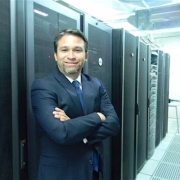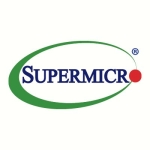
HPE BladeSystem Scalability
The solution can scale.
There are 30 people, approximately, who can access the console and manage the whole platform. The server that we have inside of it is related to the virtualization and might have more than 1000 users.
View full review »I rate its scalability a ten out of ten. It has the ability to expand and scale effectively.
View full review »For scalability, I’d rate HPE BladeSystem a nine. We have over three thousand users connected to the system, and we operate a hybrid cloud environment with both on-prem and cloud resources. While we still use BladeSystem, we’re planning to upgrade to Synergy in the future.
View full review »Buyer's Guide
HPE BladeSystem
April 2025
Learn what your peers think about HPE BladeSystem. Get advice and tips from experienced pros sharing their opinions. Updated: April 2025.
848,716 professionals have used our research since 2012.
We have never reached a threshold on scalability with the c7000. With multiple I/O interconnects on the backplane, we have never maxed out its capabilities.
View full review »There aren’t many complaints about the scalability; the system is quite robust. However, a notable issue occurred in a large telco company where HPE servers were more affected by environmental issues compared to others.
View full review »We did not scale our BladeSystem. Instead, when we needed more workloads, we opted to use cloud solutions such as AWS and did not upgrade the on-premise BladeSystem.
View full review »JN
Jurie NOrtje
Senior IT Operations Specialist at Denel
The product's scalability is quite significant.
Scalability-wise, I rate the solution a ten out of ten.
Around 20 users are using HPE in my company.
The solution is extensively used.
I do have plans to increase the usage of the solution.
We don’t have issues with computer power scalability. We just add more blades, configure, install and go, or add more memory to an existing blade.
HPE also supports mixing several blade models in the same cabinet.
You can have, for instance, BL460c G7, BL460c Gen8, and BL460c Gen9 working smoothly in the same C-Class enclosure.
View full review »The scalability is excellent, and it even takes up less space than, for example, IBM, and uses less energy.
I'm not sure, overall, how many users actually use the product in our organization.
View full review »WG
William Griffiths
Systems Analyst at BCFSA
We haven't done a ton of scalability. So, I don't have any thoughts on that.
In terms of its usage, we're a regulator. We are representing five industries right now. We probably have a couple of thousand people using it on their external site accessing it, but internally, we're a small organization. We only have about 300 employees. Our infrastructure team has three people right now, and we are hiring two more infrastructure people. We're not huge. In theory, one person does pretty much all the maintenance.
View full review »The solution can scale well.
View full review »NR
Nugroho Cahyo Riadmojo
IT Network And Infrastructure Engineer at a manufacturing company with 201-500 employees
There were scalability issues. If we want to upgrade, the oldest version of the blade server cannot be mixed with the newest one. This is a problem of the firmware compatibility matrix of the on-board administrator.
View full review »I rate the product’s scalability a ten out of ten. It is suitable for small and medium businesses.
View full review »I rate the scalability of HPE BladeSystem a nine out of ten.
View full review »NM
Naief Mubarek
IT Manager at Umm Al-Qura University
I believe BladeSystem is more scalable than HCI. If I want to add more storage or more memory on HCI, I have to add additional notes. With Blade, if I need extra storage, it's just a matter of additional discs.
HPE BladeSystem is a scalable solution. It is a composable infrastructure which we can manage our external services. This is the one factor which I can see the server is much more suitable for the OneView console.
View full review »As our business grows the HPE BladeSystem is scalable.
We have approximately 400 people using the solution in my organization. We plan to increase the usage in the future.
View full review »The scalability is good. If a company needs to expand it out, they should be able to do so.
Our company has over 5,000 users on this solution.
We will continue to use the solution into the future.
View full review »No issues encountered.
View full review »You cannot really scale a BladeSystem. If I were using it in conjunction with VMware, then we are able to upgrade or get a higher CPU or memory on a virtual machine or move a virtual machine in a different blade that has a higher CPU and memory. If it comes to that, yes, using other software, scalability is very good.
View full review »LA
Laith Aljawamis
Senior Executive Manager - Data Center Virtualization at a insurance company with 1,001-5,000 employees
It is a scalable solution.
I would rate the scalability of HPE BladeSystem, an eight out of ten.
View full review »I give the scalability a nine out of ten.
We have around ten administrators using the solution in our organization.
View full review »The solution is scalable.
View full review »We have 1200 users.
View full review »JR
Joseph Raisi
IT Manager at Botswana Accountancy College
We haven't tried to expand the solution. We have around 3,000 students and 255 staff members who use this solution.
View full review »PS
Philip Sellers
Solutions Engineer at AmWINS Group, Inc.
Multiple enclosures at scale can introduce challenges. That's one of the downsides of a ten year old technology. HPE is working on new solutions to really hit scale issues that they have encountered with BladeSystem, but it works fine for us. We are a small to medium sized enterprise, so we've not encountered any major issues with scalability where we are at, but we are running one enclosure per sight, so we're not really trying to do scale things.
View full review »No issues encountered.
View full review »KL
Kavinda Herath
Network Engineer at Lyceum
The solution is scalable. We have employees using this solution remotely and locally, so I believe there are more than 200 users.
View full review »The solution can scale. It is a bit limited, however.
View full review »SR
Sharique Rizvi
Subject Matter Expert at Cyprobes
They can scale if it is required.
We have more than 1,000 users on the solution right now.
View full review »RA
Reginaldo Aires Junior
Systems Engineer at AXA Assistance US
The solution is scalable, we have approximately 3,000 people that use this solution.
View full review »No issues with scalability.
View full review »The solution can scale well. It's not a problem if a company wants to expand it.
We have thousands of people that use it.
View full review »EN
Ehab Nafea
Infrastructure Architecture & Planning Manager at a financial services firm with 1,001-5,000 employees
It is scalable and suitable for our organization. We have not reached the maximum that HPE Bladesystem can reach.
View full review »So really the main thing we've had was just the firmware with virtual connects can be a little touchy. There's another tool, I can't even remember what it's called, you can do a command line and avoid the issue, talking to our hospitalier but we haven't had a chance so what we've kind of done is made a whole chassis of failure domain which is kind of a waste of resources on occasion to avoid that.
View full review »For small/medium sized businesses, the C-series blade chassis are great for the reasons I’ve said (they come in the right-sized bites).
If you’re a small business, you don’t want a blade chassis; but if you’re enormous, then you’re buying them by the rack (so perhaps UCS makes sense).
But for us, we needed the right-sized chassis, for which HP is the right fit. We’re going to go heavier into it, and I’m leaning toward us standing up the next production database in blades.
View full review »The solution can definitely scale. If a company needs to expand it, it can do so with ease.
We have about 2,000 end-users currently.
We do plan to continue to use the solution.
View full review »SF
Sabrin Freedman Alexander
Lead Systems Administrator at a healthcare company with 1,001-5,000 employees
We have not encountered any scalability issues. It's extremely scalable. If you run out of resources, just get another blade server and you've added another x amount of RAM and CPU to your environment.
ES
Elliott Scott
CEO at Scott Solutions LLC
I've never experienced an issue with hardware scalability.
View full review »The HPE BladeSystem is extremely scalable.
We have some clients that have thousands and hundreds of people using the solution.
View full review »For our purposes, it has worked exactly the way we expected it to.
It has been very scalable for us. We have been able to add additional servers, add additional C7000 chassis, and it just continues to work. It has been very scalable and worked very well.
We have two C7000s, and a total of 17 blade servers. Most of the servers have the attached storage blade for increased storage, besides what's in the blade itself.
Our initial implementation included a couple of NAS units, but they were very slow, which is why we went with the storage blade units. That gave us better performance.
We have upgraded to some newer NAS units from HPE, and they've worked very well for us, which is why we are starting to slowly shift in that direction. That may change now since we're going to have to go with a new platform the next time we do an upgrade.
View full review »It is scalable. I think that it is like HPE Virtual Connect Enterprise Manager Software. You can configure the network from a central location for all enclosures. We have more than four or five enclosures. That is very good for us.
That's why I would recommend having one stack of vendor products. For example, we have HPE blade servers, some network devices, and some switches. This way, you can integrate and monitor the health status for all enclosures from a single monitor. You are alerted if any failure occurs. That makes our life easier in IT; so it's good.
View full review »It's easy. If we need to add servers, it's very simple. We don't add and subtract a lot of servers. Our environment is pretty stable. I'm not looking for hyper-quick deployment of servers and things like that. I will look into being able to get into where if a server fails, that profile can quickly go over to another profile on another server. That would be nice to have that feature.
View full review »We try to keep a blade server on a three-year lifecycle. When that one's ready to come out of that slot in the rack, you can pull out a G64-60, and you can put in a different architecture as long as it's a single form factor. I like that scalability real well.
View full review »The solution is scalable, offering flexibility and expansion options to meet changing business needs.
View full review »It is very scalable. The entire banking industry in Nigeria is connected to this solution. Everybody in the industry uses this solution. We intend to grow and increase its usage.
View full review »We can have, if I remember correctly, 16 blades or something like that. We can have a half blade or full-size blade, so it's a way to manage our rack with the maximum scalability according to the power that we need.
View full review »It’s pretty scalable. I came from an environment that had 60 Blade enclosures. We went to Virtual Connect Enterprise for manageability, because the domains were locked to four when you did a stacking cable. There are some limits inside the Virtual Connect Enterprise Manager, but we couldn't find them.
View full review »We can change anytime. We can add a blade, or add RAM. In fact we did a process last summer where we went and doubled the RAM in each of the blades. That was the one limitation we had, we don't have to go "Okay, well I've got a few Megs here, I've got a few Gigs here, I can move things around." Making the workload larger, or smaller everything works very well. We're not big on hyperconvergence, but we love the ability to be able to add and subtract if we need to.
View full review »It’s scalable enough for our purposes.
We can put 2 chassis together in a rack, 16 blades per chassis. With this scalability, we can see that it provides all the capacity we envision needing for the foreseeable future. We’re also evolving our software to take further advantage of this platform's scalability (part of 4G LTE systems).
View full review »It is easy to scale. You can connect as many servers as you need depending on your account type.
View full review »It's able to scale very well. That's one of the benefits of it.
View full review »Architecturally, there's no problem adding more of those as the environment needs to scale.
View full review »The systems scale well for our environment.
View full review »We run a virtual environment, a private cloud. As I need more computer power, we're able to add C7000 chassis Blade servers in, and just add those to the firm. It was relatively easy. It's getting it into production and then adding them into the cluster.
View full review »The scalability is great.
View full review »BB
SrEngineer672
Consultant at a tech services company with 51-200 employees
No, these servers when specified can host incredible amounts of VM's. The CPU options and RAM expansions are very good.
View full review »We haven't done much scaling. We are managing the individual BladeSystems.
View full review »We have not gone full scale with it. We only have it in small areas of the data center at the moment.
View full review »Every three or four years, we review our hardware estate. We're going through a process right now to increase the capacity in our estate. We do a complete application review and we understand what infrastructure environment is needed to support that.
View full review »You scale within the enclosure. You get 16 servers and then you can buy extra enclosures. It's scalable.
View full review »We've been expanding most of it, going with solid state storage has been the latest set of upgrades that we've done to it, and continuing to grow that. From a backup standpoint, we're also looking if we can start to use a lower tiered storage and use that to house all of the backups that we'll do, so we can get off using tapes as part of our whole strategy. We've got nine branch centers that ultimately are consolidating into the data center, so we're trying to fan those down into the data center and back them up.
View full review »We use about half of each chassis that we have in place and we have redundant chassis just in case a chassis should go down. It has never happened but from a scalability stand-point we continue to increase the amount of blades we use in each of those racks, each of those chassis.
View full review »We have about 70 users per site and we have 700 sites. It's scaled nicely for us.
View full review »JI
Jitendra Injam
System Analyst at a university with 201-500 employees
The HPE BladeSystem can scale very well.
We have approximately 2,000 users using the HPE BladeSystem. We have many students and professors using it.
We are using HPE BladeSystem on a daily basis.
View full review »We are a small-sized company.
View full review »As it is the hardware that all the applications are running on, it is not like software. You know what you are using and the capacity, it is not like scaling the number of users. The capability of the hardware can be upgraded and more blades can be added. So it is scalable. We are definitely going to continue to use this product and we will scale it as needed.
View full review »In general, I did not encounter any issues with scalability. Though we did run into incompatibility issues with a recent blade purchase that was incompatible with our existing fiber channel ports.
View full review »There were no scalability issues.
View full review »You can get a blade that uses two slots instead of one. You can even put Integrity blade systems on the chassis as well, or the old Titanium systems. They can use up to four slots, actually. It's quite scalable.
View full review »We haven’t really had to scale, but we can provision them usually from the get-go for what we do.
View full review »There were no scalability issues. When upgrading to higher speeds, the backplane could be problematic. For example, when going to 16Gb fibre and 40Gb LAN requires one to go from the G1 and G2 to the later G3. Upgrading to the new 32 and 128Gb SAN is not possible.
View full review »Scalability is perfect.
View full review »We have a thousand servers and five thousand users, so in terms of scalability, yes, it's been scalable and we're able to expand more if necessary.
View full review »We went from 60 physical servers to 10 blades. We've been able to add more blades in our recent projects as well as to upgrade them. So, no, there have been no scalability issues.
View full review »I did not encounter any scalability issues.
View full review »It is excellent on scalability.
View full review »Scalability comes without saying. HP has scalable storage and I'd like to thank them for requisitioning 3PAR as that's actually added good technology. They worked with us to migrate from old systems.
View full review »The scalability is limited because you only have a 16-server by chassis, so you have to add more chassis, and you can't have a domain fabric like HPE Synergy, for example. You would need to have a taskforce behind the chassis to make the network possible, between the chassis, rather than a solution which is fully integrated via a domain fabric network solution.
Behind a domain fabric, you can connect something like 20 chassis. With this technology, we will have a real scale-out possibility, rather than the C7000 chassis which does not scale out.
View full review »Firmware dependencies with older generations of HP servers.
View full review »All good.
View full review »That's a non-issue for us. They're easy to scale especially with the blade chassis. We stack several of them into a rack, stick in more blades whenever we need to.
View full review »The scalability is okay.
View full review »OY
Orhangazi Yıldırım
System Architect at KT Bank
The scalability is very flexible. You are not limited to any spec like server type, network, or fiber module differences.
View full review »There were no scalability issues.
View full review »We used VMware as a hypervisor on top of our BladeSystems, on our Blade Chassis, and on our blade server. It made it much more scalable for us to be able to spin up new architecture fairly quickly. What we've done is rolled back or moved, relocated some blades from one Chassis to another that didn't have virtual connect.
View full review »It's been able to scale for our needs.
View full review »SC
Simon Chaba
ICT Manager at a aerospace/defense firm
No issues encountered.
View full review »The problem is that when want to expand with a new chassis, you have to do everything manually. It's not automatic.
View full review »It's scaling where we need to go.
View full review »We have had no issues with scalability. We have added ProLiant servers to the chassis which shares storage.
View full review »It's very scalable as we keep adding more blades as needed. With one enclosure, we can have 16 blades or just three. I don't think we'll ever go back to the old DL3x.
View full review »RB
Reviewer7839213
Scientist/Engineer 'F' with 1,001-5,000 employees
No issues.
View full review »I did not encounter any scalability issues.
View full review »It's been able to scale for our needs.
View full review »We're just about to purchase our second place in the primary site. I expect to be able to scale.
View full review »While the solution is pretty scalable, every company has its own context. Therefore, the scaling process might be different. In my future plans, for example, it's hard to reduce my footprint, as the workload has moved to CoW. Something that's based on-premise has limited parameters. That's why I'm trying to use the totally hyper-converged system.
I did not encounter any issues with scalability.
View full review »The scalability is great.
View full review »It's scalable.
View full review »It's just about connecting more, so it's scalable in that way.
View full review »We have lot of space to go with new blades and the whole environment is organized, so it's really easy to put in the new hosts, or new Blades in this case, into the new regular machines.
No issues with scalability. We can scale by adding another enclosure.
View full review »It scales fine for tens of thousands of things.
View full review »No issues.
View full review »AH
Ahmad Hassan
Technical Consultant at a tech services company with 201-500 employees
None at all.
View full review »Sometimes there are scalability issues with relatively older generations.
View full review »We only need to add more blades, which makes it as scalable as we can need or afford.
View full review »Excellent scalability, good flexibility from both a vertical and horizontal perspective.
View full review »When we need to grow, we just buy another BladeSystem and ProLiant, then add it to the system. It's modular, so we can simply add in devices when we need.
View full review »The solution is scalable.
No issues with scalability.
View full review »It's scalable, but expensive because you have to buy additional blades.
View full review »For scalability, it is better to work withHPE Apollo servers, which is not what we are using. I think HPE provides all the products that work better and quicker.
View full review »It's been able to scale for our needs.
View full review »It's been able to scale for our needs.
View full review »AB
Alfousseynou Bomou
Engineer at Platform Technique
No issues.
View full review »BladeSystem is scalable, but I think it needs to have a little more scalability of input in the future.
View full review »The scalability is very good.
View full review »Buyer's Guide
HPE BladeSystem
April 2025
Learn what your peers think about HPE BladeSystem. Get advice and tips from experienced pros sharing their opinions. Updated: April 2025.
848,716 professionals have used our research since 2012.























